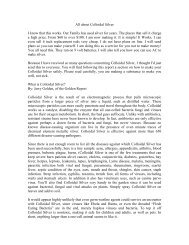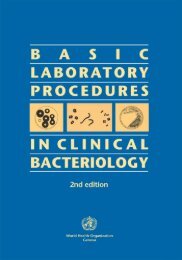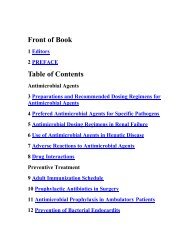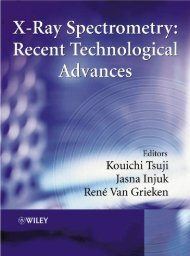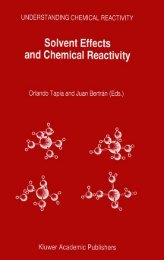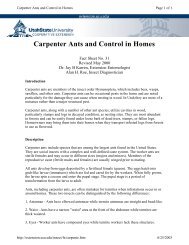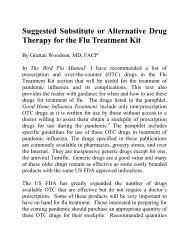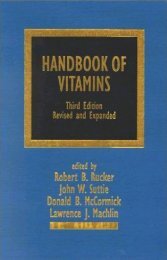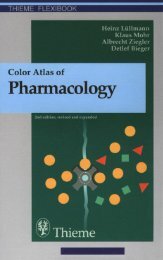The Nutritional Biochemistry of Chromium(III) - Survival-training.info
The Nutritional Biochemistry of Chromium(III) - Survival-training.info
The Nutritional Biochemistry of Chromium(III) - Survival-training.info
Create successful ePaper yourself
Turn your PDF publications into a flip-book with our unique Google optimized e-Paper software.
Introduction: A history <strong>of</strong> chromium studies (1955–1995) 5test. <strong>The</strong> material was also found to be comprised <strong>of</strong> at least six amino acids tentativelyidentified as leucine or isoleucine, proline, valine, alanine, serine, and either glutamic oraspartic acid. <strong>The</strong> material when administered orally to rats (2 ng Cr) resulted in betterchromium absorption than when chromic chloride was given [17].Mertz and coworkers reported the details <strong>of</strong> the isolation <strong>of</strong> Brewer’s yeast “GTF”in 1977 nearly 20 years after the initial report [18]. Brewer’s yeast was extracted withboiling 50% ethanol. <strong>The</strong> ethanol was removed under vacuum, and the aqueous residualwas applied to activated charcoal. Material active in bioassays (vide infra) was elutedfrom the charcoal with a 1:1 mixture <strong>of</strong> concentrated ammonia and diethyl ether. Afterremoval <strong>of</strong> the ammonia and ether under vacuum, the resulting solution was hydrolyzedby refluxing for 18 hours in 5 M HCl. Finally, the HCl was removed under vacuum,the solution was extracted with ether, and the pH <strong>of</strong> the solution was adjusted to 3. <strong>The</strong>cationic orange-red material was further purified by ion exchange chromatography [18].Unfortunately, these incredibly harsh conditions would have destroyed any proteins orpeptides or nucleic acids that initially could have been associated with the chromium.Thus, the cases that the form <strong>of</strong> chromium recovered after the treatment resembles theform in the yeast are remote at best.<strong>The</strong> isolated “GTF” possessed a distinct feature at 262 nm in its ultravioletspectrum, while mass spectral studies (no data presented) indicated the presence <strong>of</strong> apyridine moiety [18]. This led to the identification <strong>of</strong> nicotinic acid as a component<strong>of</strong> “GTF”; nicotinic acid was sublimed from the material (no experimental <strong>info</strong>rmationgiven) and identified by extraction with organic solvents (no data presented). Aminoacid analyses indicated the presence <strong>of</strong> glycine, glutamic acid, and cysteine as well as otheramino acids, although the relative amounts were not reported. <strong>The</strong> results were interpretedto indicate that “GTF” was a complex <strong>of</strong> Cr, nicotinate, glycine, cysteine, and glutamate.<strong>The</strong> properties <strong>of</strong> “GTF” were compared to those synthetic complex(es) preparedfrom Cr 3+ and nicotinic acids and the above-mentioned amino acids [18]. <strong>The</strong> materialwas found to possess an approximate composition <strong>of</strong> 1 Cr:2 nicotinate:2 glycine:1 glutamate:1cysteine, but these components only accounted for 88% <strong>of</strong> the material. <strong>The</strong> syntheticmaterial and the material from Brewer’s yeast behaved similarly upon ion exchangeand size exclusion chromatography (unfortunately no estimate <strong>of</strong> molecular weight wasgiven), as the major component <strong>of</strong> each coeluted. In paper chromatography experiments,the materials gave several bands; only one from each material was active in the bioassaysand migrated with the same R f value. <strong>The</strong> chromium in these active bands represented11 and 6% <strong>of</strong> the total chromium for the synthetic and Brewer’s yeast materials, respectively.<strong>The</strong> synthetic material and the yeast material possessed similar ultraviolet andinfrared spectra [18]. Interpretation <strong>of</strong> this work is nearly impossible. Characterization<strong>of</strong> bulk materials <strong>of</strong> which only a tiny minority is active does not allow for clearlydeciphering the composition <strong>of</strong> the active component(s). Thus, one cannot assume thatthe amino acid analysis <strong>of</strong> the bulk product reflects the “active” component. Because <strong>of</strong>the destructive isolation procedure used to obtain the chromium material from Brewer’syeast (that destroyed proteins from which the observed amino acids were probably generatedand also contained conditions under which nicotinate could have been chemicallygenerated from other compounds), the nature <strong>of</strong> the form <strong>of</strong> chromium in Brewer’s yeastwas not successfully determined. <strong>The</strong> orange-red color associated with both materials isalso notable and could suggest that ammonia is present as a chromium ligand.



